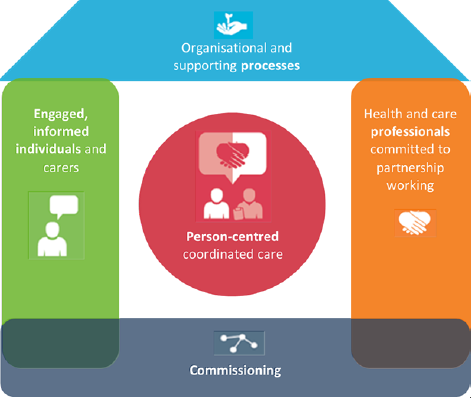How to achieve person-centred care in everyday practice
Christine Rowland, Research Fellow, Division of Nursing, Midwifery and Social Work/CLAHRC GM
You may have heard the phrase ‘person-centred care’. But have you ever given much thought as to what it really means?
Within a healthcare context, NHS England adopted the ‘House of Care framework’ to facilitate a new way of working within the NHS. It moves away from a medical-model of care (i.e., where the health care professional is the expert and tells the patient what they need to do) and puts person-centred care right at the heart of things.

Image: House of Care Framework (https://www.england.nhs.uk/ourwork/clinical-policy/ltc/house-of-care/)
While it’s clearly important to know what person-centred care is, it can be difficult to see how the theory translates into everyday practice.
We do a lot of work with family caregivers and, specifically, the Carer Support Needs Assessment Tool (CSNAT) Approach. When we meet with health care professionals we often ask about person-centred care and we get various views about what this means. As you might imagine, some of the approaches we hear about are much more person-centred then others! Often person-centeredness is attempted but ultimately the care and support given is still based on what professionals’ see as the best response to what the patient, or carer, is thought to need help with. Health care professionals are trained to ‘have the answers’ and want to be able to ‘fix’ things, but not only are they sometimes unable to ‘fix’ a problem, we’ve found that with carers sometimes it is unhelpful or actually unnecessary for them to do so. It’s not surprising though that it can be hard for the professional to step back a bit from the ‘expert’ role.
We believe that a truly person-centred approach means collaborating with people rather than the professional being the default ‘expert’ in what might be best for the person they are seeing. In fact, NHS England say the House of Care and person-centredness means the person is invited to share their experiences and expertise in their condition and explore with professionals how their resources and communities can be utilised, alongside or instead of clinical care, to meet any needs.
When we explore these ideas with health care professionals, they see themselves as working in a person-centred way. However, when we ask about what they actually do in practice, we find that many professionals are still taking the lead in establishing what a carer’s needs are, finding solutions and being the ‘expert’ in the consultation. It is important to get across the sometimes subtle differences between what is actually happening versus what should happen to be truly person-centred.
To try and help with this we made a short animated video. In fact, we just finished it last week! It was such a creative and fun way to really consider how we communicate about person-centred care in our work.
We hope it explains in an accessible way how the CSNAT Approach can help professionals link all the parts of the House of Care so that a truly person-centred approach to carer support and assessment can be achieved. It might also help practitioners think about how to work in person-centred ways more generally.
The video is about five minutes long and highlights the things I’ve talked about in this blog. You can watch it here and if you’ve got any feedback or thoughts about it we’d love to hear from you – our Twitter handle is @CSNAT_
Date Published: 13/02/2019